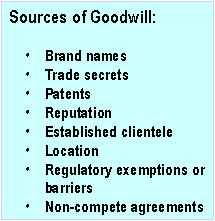Goodwill
Goodwill is the price paid to acquire a company in excess of the value of its tangible and identifiable intangible assets.
The purchase price is first allocated to assets on the acquired company's balance sheet like receivables, inventory, and PP&E. Often, these items are stepped up to fair market value. After allocation of the purchase price across assets, the remainder is recorded as Goodwill, to be amortized over a period no greater than 40 years.
Accounting conservatism casts a particularly wary eye on intangibles. While goodwill is not subject to revaluation if the acquisition works out, it is subject to write-off if it doesn't.
Economics of Goodwill
If the acquisition was appropriately priced, goodwill would represent any of several factors that enable the acquirer to generate income including brands, trade secrets, good reputation, or similar sources of economic rents.
Many of
these factors can result in permanent benefits when supported by ongoing
product performance or insurmountable barriers to entry like geography.
The value of some intangibles may fall over time, as when a franchise
gets competed away. But they could also rise, as when a business proves
the viability of a new service or increases trust in its brands. Such
outcomes would result in unrealized gains
or losses
For tax purposes, it is desirable to allocate as much of the purchase price as possible to inventory and other wasting assets so as to create the greatest charge in the earliest periods where a tax shield exists on such charges.
Certain kinds of goodwill, primarily acquired brands that fall under certain criteria, are tax deductible. Even so, there may be other categories for "brand equity" to which those amounts could be allocated that would provide faster tax amortization than that allowed for brands.
Behavioral Impact
Pre-acquisition, the effect of goodwill should be inconsequential. The recording of goodwill insures that the full purchase price is reflected in capital, which is the appropriate basis for assessing the sufficiency of future returns.
Post-acquisition, the impact of a 40 year amortization is admittedly small. When focusing on changes in EP, whether goodwill is amortized or not usually makes little difference. However, amortization of a large amount of goodwill for truly permanent assets can create the illusion of growing EP. And when the goodwill has finally amortized away, the sudden loss of a goodwill amortization charge can create a bump in EP, although no economic event has triggered this bump.
While these effects would not likely affect decision making, they still represent mismatching of income and capital charges that might affect how performance for a unit or management team might be judged.
Alternative Treatments
Before considering an alternative treatment for goodwill, we must first segregate goodwill into its components, based on its sources. Different sources of goodwill may warrant the current schedule of amortization, some may warrant faster amortization, some no amortization.
Eliminating goodwill amortization
To eliminate the effect of steadily growing EP as goodwill gets amortized or the significant bump in EP when amortization has ceased, we can eliminate the effect of goodwill amortization for EP purposes. This can be accompanied by either freezing net goodwill at current levels, grossing up goodwill to its original amount, or eliminating prior goodwill and only incorporating full goodwill on future purchases (i.e., "clean-slating").
The main benefit of eliminating goodwill amortization is to make it invisible to management except at the point where an acquisition is contemplated. Beyond that, an unchanged level of goodwill may represent the best match with income relative to assets. Thus, management would properly consider the full cost of a purchase when contemplating an acquisition. After the purchase, goodwill becomes a "sunk cost" without arbitrary changes to distract management, unless the asset becomes deemed impaired.